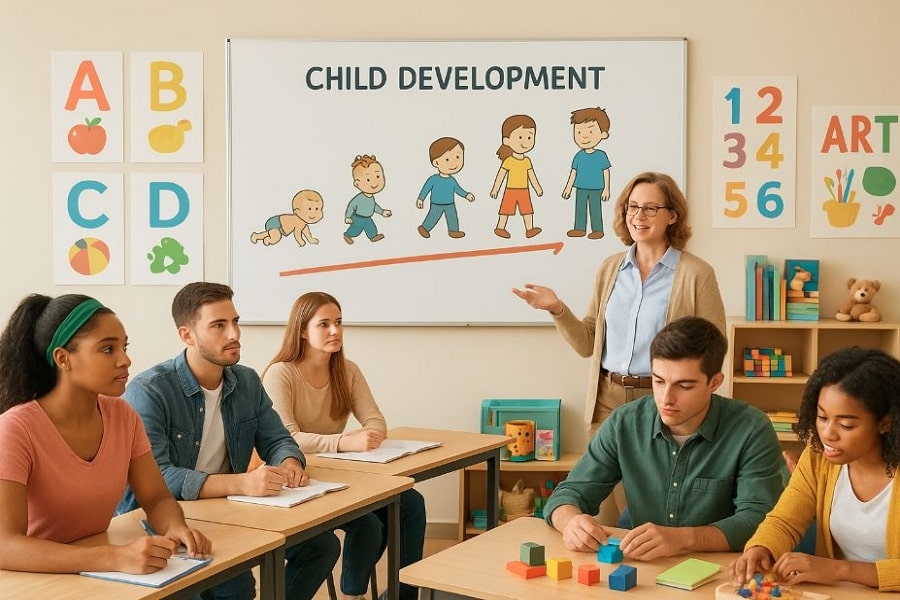If you’re passionate about teaching and shaping young minds, you might wonder: how to get a bachelor’s degree in early childhood education? This degree prepares you to work with children from birth to age 8 and opens doors to careers like preschool teacher, childcare director, or curriculum specialist.
It typically takes 3–4 years and includes both classroom learning and practical teaching experience.
In this guide, we’ll cover:
Admission requirements
How many years the program takes
Subjects and curriculum
Costs and scholarships
International student steps
Career opportunities
Let’s break it down step by step.
Is a Bachelor’s in Early Childhood Education Right for You?
Who Should Consider This Degree?
This degree is ideal if you:
Enjoy working with young children.
Want a career in teaching, childcare, or education policy.
See yourself helping children develop through play and learning.
Career Opportunities
With this degree, you could become:
Preschool or kindergarten teacher
Childcare center director
Special education assistant
Curriculum planner
Family support specialist
According to the U.S. Bureau of Labor Statistics, demand for preschool teachers is expected to grow steadily in the coming years.
Early Childhood Education Degree Requirements
To get started, you’ll need to meet certain conditions. These may vary depending on the university and country.
Academic Requirements
High school diploma or GED (or equivalent).
Recommended subjects: English, psychology, math, and biology.
Minimum GPA (often between 2.5–3.0).
Application Materials
Completed application form.
Official transcripts.
Personal statement (explaining your interest in early childhood education).
1–3 recommendation letters.
Other Requirements
Background check (since you’ll be working with children).
Health screenings and immunizations.
CPR/first aid certification (sometimes required).
How Many Years Does It Take?
A Bachelor of Early Childhood Education usually takes:
3–4 years full-time.
2–3 years if you transfer credits or choose an accelerated program.
4–6 years part-time or online.
Example 4-Year Study Plan
| Year | Focus | Courses | Notes |
|---|---|---|---|
| Year 1 | Foundations | Intro to Child Development, Education Basics | Build core skills |
| Year 2 | Core | Early Literacy, Psychology, Curriculum Studies | Apply learning to classrooms |
| Year 3 | Preparation | Classroom Management, Family Engagement | Observation + teaching practice |
| Year 4 | Final Year | Student Teaching + Capstone Project | Prepare for certification |
Core Subjects You’ll Study
Most programs cover similar topics. Common Bachelor of Early Childhood Education subjects include:
Child Growth & Development
Early Literacy and Language
Classroom Management
Curriculum Design
Family and Community Partnerships
Inclusive Education (support needs)
Play-Based Learning
Practical Training (Practicum)
Observation hours in classrooms.
Hands-on teaching under supervision.
A student-teaching semester in your final year.
Accreditation — Why It Matters?
Accreditation guarantees that your degree meets education standards.
In the U.S., look for CAEP-accredited programs.
In Canada, check provincial education ministry approvals.
In the UK & Australia, confirm recognition by national teacher registration boards.
Without accreditation, you may not qualify for teacher certification.
Certification & Licensure
After graduation, you’ll usually need a teaching license.
United States: Pass state exams (like Praxis) + degree.
Canada: Apply to provincial teaching boards.
UK & Australia: Register with the teacher accreditation body.
You may also need:
First Aid certification
Child protection training
For International Students
If you’re an international student, here are extra steps:
Provide credential evaluation (e.g., WES).
Show English language test results (IELTS/TOEFL).
Submit translated transcripts.
Apply for a student visa and provide proof of funds.
Many universities offer scholarships for international students in education.
Online vs On-Campus
Online Programs
Flexible schedule.
Lower costs.
Still require practicum hours in a local school.
On-Campus Programs
Traditional structure.
Easier networking.
Practicum placements arranged by the university.
Costs & Scholarships
Costs vary by country:
U.S.: $25,000–$40,000/year
Canada: CAD 15,000–25,000/year
UK: £12,000–25,000/year
Australia: AUD 20,000–35,000/year
Ways to Pay
Federal or state loans
Scholarships and grants
Work-study programs
Employer sponsorships
Save money by starting at community college, then transferring credits.
Application Timeline Checklist
12–18 months before: Research accredited programs.
6–12 months before: Prepare transcripts and recommendations.
6 months before: Apply for admission and scholarships.
3 months before: Secure visa, housing, finances.
Start of program: Orientation + classes begin.
Career Outcomes
With this degree, you can expect:
Job Roles
Preschool or kindergarten teacher
Childcare program director
Curriculum designer
Early intervention specialist
Salary Ranges
U.S.: $30,000–55,000
Canada: CAD 40,000–65,000
UK: £20,000–45,000
Australia: AUD 45,000–70,000
Next Steps
Master’s in Early Childhood Education
Special education programs
Leadership or education policy roles
FAQs
1. How long does the degree take?
Most full-time programs take 3–4 years.
2. Do I need student teaching?
Yes, all accredited programs require it.
3. Can international students apply?
Yes, but they must meet language and visa requirements.
4. Is an online degree valid?
Yes, if the program is accredited.
5. What subjects will I study?
Child development, literacy, curriculum, classroom management, and practicum.
Last Word
Getting a Bachelor’s degree in Early Childhood Education is the first step to a fulfilling career in teaching and child development.
By choosing an accredited program, meeting admission requirements, and planning your career path, you’ll be prepared for licensure and a successful career helping children learn and grow.
Start today by researching accredited programs and mapping out your application plan.

